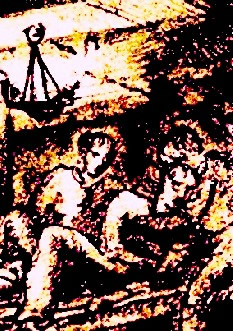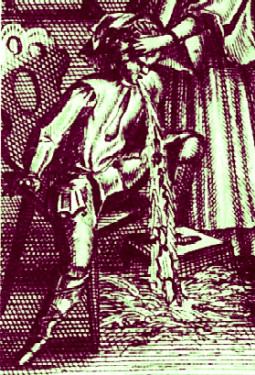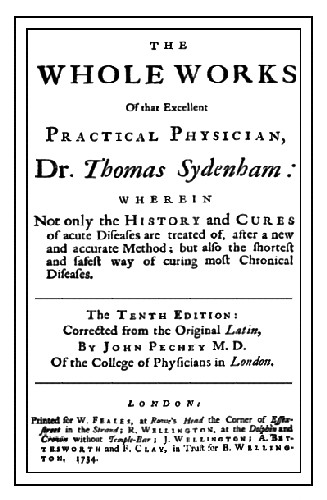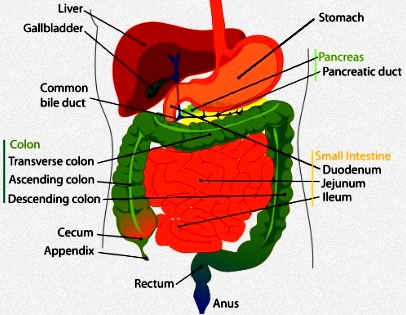
Fluxes/Diarrhea and Related Illnesses Page Menu: 1 2 3 4 5 6 7 8 9 10 11 Next>>
Treating Fluxes in the Golden Age of Piracy, Page 1
"At his return to Madagascar, [Pirate Captain Thomas] White was taken ill of a flux, which in about five or six months ended his days." (Captain Charles Johnson, The History of the Pirates, p. 122)
A flux is a flow of something. Golden age of piracy era surgeons used the word to refer to many things including outflows of blood from a wound, the flowing of the elusive "humors" towards or away from a wound and, most commonly of all, the flux of the bowels - what we today commonly call diarrhea and dysentery. The bloody flux (or dysentery) was widely feared because it was sometimes a precursor of death, as happened with Captain White.

Ill in the Cockpit, unknown artist (1820)
Fluxes appear to have been particularly problematic for sailors. In the introductory remarks to his book The Sea Chirurgeon, John Moyle explains that "there are some distempers more usual at Sea than others, (as Fevers, Fluxes, Scurvy, Wounds, Contusions, Fractures) and there ought in a more especial manner to be provided for."1 Indeed, he thought it so relevant to the sea surgeon, that Moyle devotes an entire chapter to the subject2, as do sea-surgeon authors John Woodall in the book the surgions mate3 and Thomas Aubrey in his book The Sea-Surgeon or the Guinea Man’s Vadé Mecum4. William Cockburn, one of the first British Royal Navy fleet-assigned physicians, published an entire 319 page book [not including the introduction or appendix] on the topic. So this was clearly an illness of great concern at sea.
Woodall noted that while " this disease in our climate [London] for the most part by skilfull Phisitions and Surgeons is well and speedily cured, in the Indies it is very hardly cured, in so much that many have died of it, particularly by great wilfulnesse and disorder of the Patient, and by your leave also by the ignorance of the Surgeon being a thing they had not beene warned of before, nor practiced in, and by not having good remedies and instruments first at hand to give men helpe".5

Photo: Peter Isotalo
The toilets in the prow [or beakhead] of the 1627 Vasa Warship.
(They are the two
rectangular
tubes seen on either side of the jib boom.)
Woodall had much to say on the topic, devoting more text in his manual than any other sea-surgeon to the topic. He was greatly concerned with the comfort of the men during this clearly ever-present problem. By way of example, he warned newly minted sea surgeon that they "...among other things [are] needfull [of] instrument[s] for poor Seamen in fluxes, never be[ing] unfurnished in the shippe of one or two close stooles with doores to them, and brasse pailes, that poore miserable men in their weaknes may be eased thereon; and not constrained to goe to either the beake head, or shrouds (as they terme it) for that not onely increaseth the disease, but also causeth the falling downe of
the Arse-gut, a fearefull accident... [which] may easily be the death of the patient; whose blood will cry to God for revenge: Wherefore young Artists that professe to feare the Almighty, be compassionate to the meanest creature in this disease, even as you would other should do to you in the like case, and not otherwise."6
The seamen were likewise greatly concerned with the skill of the surgeon in dealing

Artist: Willem van de Velde Younger
4th Rate Warship HMS Resolution -
similar to the HMS James Galley
with diarrhea and the bloody flux. Kevin Brown reports in his book that the men "aboard the James Galley in 1680 had nothing but praise for their surgeon:
We the mariners belonging to His Majesty's Ship James Galley have many of us been desperately sick of malignant fevers and fluxes, and by the scurvy, and others of the crew were wounded and bruised by accidents aboard the same ship but all of us and many more have been safely cured again by the care and skill of our chirurgion in Mr John Moyle who hath... sufficiently proved himself both a very able surgeon and an honest man by his behaviour, hath been so civil towards all men that he hath an extraordinary respect from the ship's company in general.7
Both merchant ship captain Thomas Phillips and his consort ship captain Thomas Shurley came down with fluxes while off the coast of Africa. Phillips explains in May of 1694, "Capt. Shurley has been long sick of a flux and fever, and is now very ill, and I troubled with violent convulsions in my head, that I can get no sleep without opiates, and so giddy that I cannot walk without assistance"8. While Phillips eventually recovered from his flux, Shurley did not.

Boy Vomiting, From De Incantamentis, By George
Abraham Mercklin (1715)
Privateer George Shelvocke detailed such a problem which struck their voyage after leaving Puerto Seguro (modern Cabo San Lucas, Mexico) in early September of 1721. "A fortnight after we had left California, my People, who had hitherto enjoy'd an uninterrupted state of health, began to be afflicted with a sickness, which particularly affected their stomachs"9. Shelvocke blamed their diet which he said included "quantities of sweetmeats [candy] they were continually devouring, and also to our common food, which was puddings made of very coarse flour and sweet meats, and salt water instead of fresh to moisten them, and dry'd beef, which was partly destroy 'd by ants, cockroaches, and other vermin"10. He noted that because they had no medicines to treat the problem (having lost them in a shipwreck the previous year), "this sickness encreased upon us every day, insomuch that but of our small number we buried two in one day"11.
The illness continued for quite some time, with Shelvocke rather dramatically explaining that in October of the same year, "those of us that were thus out of order, were very subject to fainting fits, in which my people had two or three times given me over for dead, but they did not last long."12
By now it can be seen that this was a serious illness, of great concern to the sea surgeon. This article will look at the various types of fluxes that sailors faced, then consider what surgeons during this time believed to be the causes of these fluxes. It will then detail the various cures that were tried and will conclude with a complete cure explained by the eminent physician Dr. Thomas Sydenham which incorporates many of the remedies discussed in the period texts.
1 John Moyle, The Sea Chirurgeon, p. 2; 2 Moyle,p. 169-78; 3 John Woodall, the surgions mate, p. 202-16; 4 Thomas Aubrey The Sea-Surgeon or the Guinea Man’s Vadé Mecum., p. 74-89; 5 Woodall, p. 205; 6 Woodall, p. 205-6; 7 Kevin Brown, Poxed and Scurvied: The Story of Sickness and Health at Sea, p. 49; 8 Thomas Phillips, 'A Journal of a Voyage Made in the Hannibal', A Collection of Voyages and Travels, Vol. VI, Awnsham Churchill. ed., p.211; 9 George Shelvocke, A Voyage Round the World by Way of the Great South Sea, 1726, p. 434; 10 Shelvocke, p. 434-5; 11 Shelvocke, p. 435; 12 Shelvocke, p. 437
Types of Fluxes
Broadly speaking, physicians and surgeons during the golden age of piracy identified two types of fluxes - the generic flux or diarrhea and the bloody flux or dysentery. Many surgeons further divided diarrhea into other sub-types, a few of which we'll look at.
John Woodall actually specified three types of flux. "The principall Fluxes of the belly by a common consent of divers ancient writers, are chiefly referred to three kinds, namely: Leienteria, Diarrhæa [and] Disenteria."1 John Moyle likewise identifies these three types of flux with slightly different spellings. He helpfully explains that "Lyenteria is a casting out the Aliment [food] undigested, as it was received, and that's a miserable condition. This is caused by a

deprivation of the digestive faculty, as also of the retentive; and is hurried through by putrid and slippery Flegm, that invests the Tunicles of the Stomach and Guts"2.
Of particular note in Woodall's definition is the reference to the 'ancient writers.' Surgery at this time in history was still emerging from the cocoon of the past. Many surgical writers were afraid to go against the much-revered opinions of authors such as Hippocrates, Cornelius Celsus and Galen of Pergamon. So they tip-toed around the edges of these millenia-dead physicians or offered extensive proofs as to why the ancients may have been wrong.
Practical medicine - that defined by what actually worked in practice rather than what long-gone authors had recommended - was just coming into its own in the mid-17th century. It was with no small reason that late-17th century physician Thomas Sydenham's book proclaimed itself to be by "that Eminent Practical Physician Dr. Thomas Sydenham WHEREIN ...the History and Cures of acute Disease are treated of, after a new and accurate Method"3 [emphasis mine].
At this point, we have three different types of flux, with Lienteria actually being a sort of sub-type of a generic diarrhea. Naval physician William Cockburn identifies another sub-type of flux, the Cæliac Affection, and although no period surgeon discusses, Cockburn spends a great deal of time on it, so we will look at it as well.
With this in mind, we will examine the general flux or diarrhea, the subtypes Lienteria and Cæliac Affection and the bloody flux or diarrhea.
1 John Woodall, the surgions mate, p. 202; 2 John Moyle, The Sea Chirurgeon, p. 169-70; 3 Thomas Sydenham, The Whole Works of that Excellent Practical Physician Dr. Thomas Sydenham, 10th Edition, cover page; 4 William Cockburn, The Nature and Cure of Fluxes, p. 52
Types of Fluxes: Looseness/Diarrhea
" ...none of [Bartholomew Robert's pirates at their trial],

Pirate Bartholomew Roberts
From A General History
of the
Pirates by Captain
Charles Johnson (1724)
it was observed, appeared the least dejected, unless Sutton, who spoke faint, but it was rather imputed to a Flux that had seiz'd him two or three Days before, than Fear." (Captain Charles Johnson, A General History of the Pirates, p. 326)
Anyone who's suffered from diarrhea will recognize that the term 'looseness' is quite an apt one. William Cockburn details the symptoms most graphically. He explains that they include "frequent Griping [sharp pain in the bowels] and loose Stools, full of Slime, Gall [bile, thought to be secreted by the liver], and blackish Humours. Sometimes the Stools are watry without Excrements: at other times, there is a great Abundance of Excrements, and they greasy and frothy. In time of a Diarrhœa there is commonly a great Loss of Appetite, a Fever, a weak[ness], and often, a depress'd Pulse. The Sick make but little Water [urinate infrequently] which is commonly of a natural Colour, though it is sometimes lixivial [the color of lye - white]."1
John Woodall simply defines diarrhea as "a Flux of the belly which is either meerely watrish, or with humors and with slime mixed"2. It should come as no surprise that period authors thought the liquid product of the illness contained humors. After all, humors were nothing more than various bodily fluids that impacted the health of the individual. If the digestive process was producing liquids when it should be producing solids, it was logical at this time to link this condition with humoral theory.

The Four Humors & Their Qualities
In fact, both of these authors felt that diarrhea could be a useful way to removing 'bad' humors from the patient's system. Woodall advises that "if you see that the Patient bee strong, there is no great hast[e] of stopping this disease, for that it is many times a benefit of Nature, whereby she avoideth superfluous, or venomous, or otherwise vicious and offensive humours"3.
Cockburn agreed, explaining that a diarrhea could "last till the seventh Day with Benefit to the sick Person, when it is without a Fever"4 further explaining that "unconcocted Humours may be discharged in the frequent Stools, and the Sick find the Benefit of these Stools, in the Recovery of their Health."5 This seems like a logical conclusion given that 'purging' medicines were sometimes used in other illnesses to force a patient into a diarrheic state.
Still, they also recognized that letting a flux go unchecked was inadvisable. Cockburn explained that "no Kind of Loosness but what voids great Quantities of various and unconcocted Humours, can continue with Advantage to the Sick, every other Diarrhœa getting Strength by its Duration; for the longer they last, the more violent and irremediable they become"6. In fact, he uses humoral theory to distinguish between 'good' and 'bad' diarrheas. "[A] Diarrhœa, with watry Stools, is far worse than a Diarrhœa produced by sharp Humours in the Guts, and that excite their extraordinary Contraction. For, by what has been shewn, watry Stools are Defects in the Blood, and encrease by their continuing; as, on the other Hand, a Diarrhœa from sharp Humours discharges its Cause, and is cured by continuing for some little time."7

Image by: Mariana Ruiz Villarreal - A Diagram of the Digestive System
As befits a surgeon (William Cockburn being a physician), John Woodall had a more practice-based and less theoretical view of the severity of a looseness. As he explains it in his book the surgions mate:
The higher toward the stomacke the disease hath his beginning the more dangerous it may bee adjudged. By the complaint of the sicke you shall know partly in what part of the body the disease is, though not alwaies: if the small guts be in the fault there is alwaies great paine about the navill, but if it be in the gut Duodenum colum [upper part of the small intestine], or rectum, then the chiefe paine is in the lower parts of the belly, according to their places.8
1 William Cockburn, The Nature and Cure of Fluxes, p. 21; 2 John Woodall, the surgions mate, p. 204; 3 Woodall, ibid; 4 Cockburn, ibid; 5 Cockburn, p. 46; 6 Cockburn, p. 45-6; ; 5 Cockburn, p. 82; 8 Woodall, p. 214
Types of Fluxes: Looseness/Diarrhea - A Rainbow of Diarrheic Colors
Of great fascination to period authors when considering a looseness was the color of the stool. Thomas Aubrey identifies a Diarrheic Fever by "pinguious purulent [oily pus-based] Matter of various Colours, as yellow, green, or white"1. William Cockburn notes "that yellow and bilious Stools, sharp, yellow Stools, like Yolks of Eggs, and green Stools are very bad, unless they come critically to purge the Body.
The Lees of a Merlot - I'll bet you'll never think of red wine the same way again.
Stools of a Saffron Colour are still worse, and if they are rusty and green, the more they shew of an inward Heat."2 He goes on to explain that "reddish Stools, and such as are like Lees of Wine [residual yeast - sort of reddish purple in color as seen at left] ...are very dangerous; yet they are more fatal when they are black ...a Loosness with red Stools is very dangerous; and the more, that it proceeds from a Fault in the Liver, as in cafe of an hepatick Loosness [he's probably talking about a chronic diarrhea resulting from cirrhosis]"3.
Blackness of stools could be a very serious matter according to Cockburn. He begins by explaining that any "Blackness our Stools receive from Food, Drink or Medicines...is altogether accidental, and does not sufficiently account for the Commonness of this Symptom; and the Blackness, for that Reason, must generally be produced by some natural Humours in the Body, that are some way corrupted in the time of a Diarrhœa."4However, when the "Arteries are very much stimulated, they will discharge a Quantity of Blood; which Blood quickly corrupts and becomes black. In that Case, corrupted Blood intimately mixed with the Excrements by the same Power they are expelled, this black Blood is thrown out with the Excrements; or the Excrements are found full of a blackish Humour, as often happens in a Diarrhœa."5 Red and blackish stools that contained blood were most likely a sign of a bloody flux, which is probably why Cockburn warns of it.
1 Thomas Aubrey, The Sea-Surgeon or the Guinea Man’s Vadé Mecum., p. 76; 2 William Cockburn, The Nature and Cure of Fluxes, p. 85-6; 3 Cockburn, p. 86; 4 Cockburn, p. 31; 5 Cockburn, p. 312
Types of Fluxes: Looseness/Diarrhea - Combined With Other Diseases
Period surgeons frequently noted that fluxes often came on when a patient had another illness. William Cockburn noticed that "when a Diarrhœa is the Symptom of Some other Disease, it is more

A Patient from Hy a cum et Lues
Venera by Theodor Galle (1570)
difficult to be cured than the Greatness of the Diarrhœa, This is manifest in Experience"1. He particularly commented on diarrheas that followed fevers, explaining that such fluxes were "both the hardest to be cured, and is most liable to return. Hence in all malignant Fevers a Diarrhœa can hardly ever be cured by the Medicines, commonly administred for the Cure of a Loosness; they being very opposite to the Cure of the Fever"2. Since the diarrhea was probably a symptom of the fever, treating it separately with counter-acting diseases would have been fruitless anyhow. Curing the fever would likely eliminate the diarrhea.
The other interesting comment made about diarrhea's in combination with other illnesses comes from sea surgeon John Moyle, who claims to have discovered that men "that have the Scurvy, if a Flux happens upon it, that carries off the Scurvy."3 One can only guess that whatever led Moyle to this conclusion must have involved someone eating something with vitamin C which caused them the looseness since the diarrhea taking away nutrients from the body could hardly have cured the deficiency.
1 William Cockburn, The Nature and Cure of Fluxes, p. 163; 1 Cockburn,p. 164; 3 John Moyle, The Sea Chirurgeon, p. 187

